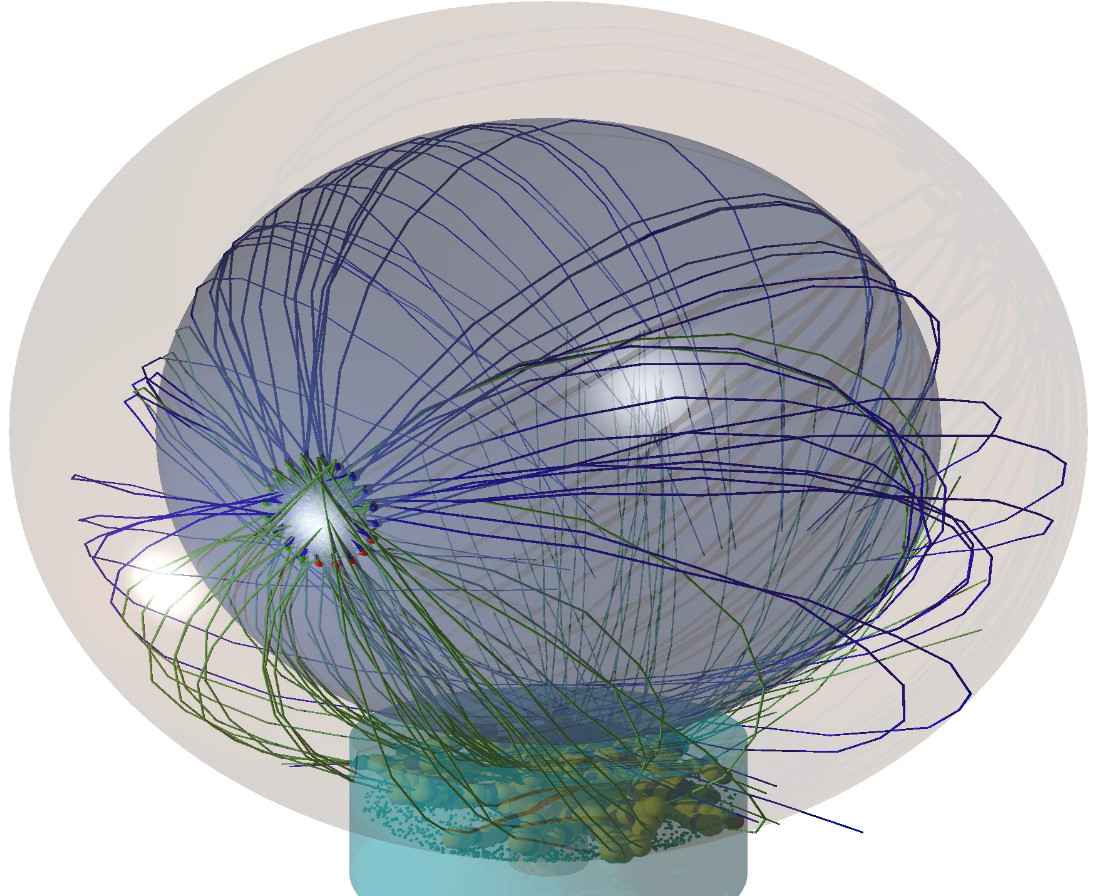AG — Prof. Heiko Rieger — Statistical Physics
Stochastic model of T Cell repolarization during target elimination

Abstract of the first part
Cytotoxic T lymphocytes (T) and natural killer (NK) cells are the main cytotoxic killer cells of the human body to eliminate pathogen-infected or tumorigenic cells (i.e. target cells). Once a NK or T cell has identified a target cell, they form a tight contact zone, the immunological synapse (IS). One then observes a re-polarization of the cell involving the rotation of the microtubule (MT) half-spindle and a movement of the microtubule organizing center (MTOC) to a position that is just underneath the plasma membrane at the center of the IS. Concomitantly a massive relocation of organelles attached to MTs is observed, including the Golgi apparatus, lytic granules and mitochondria. Since the mechanism of this relocation is still elusive we devise a theoretical model for the molecular motor driven motion of the MT half-spindle confined between plasma membrane and nucleus during T cell polarization. We analyze different scenarios currently discussed in the literature, the cortical sliding and the capture-shrinkage mechanisms, and compare quantitative predictions about the spatio-temporal evolution of MTOC position and spindle morphology with experimental observations. The model predicts the experimentally observed biphasic nature of the repositioning process due to an interplay between spindle geometry and motor forces and confirms the dominance of the capture-shrinkage over the cortical sliding mechanism when MTOC and IS are initially diametrically opposed. We also find that the two mechanisms act synergetically, thereby reducing the resources necessary for repositioning. Moreover, it turns out that the localization of dyneins in the pSMAC facilitates their interaction with the MTs. Our model also opens a way to infer details of the dynein distribution from the experimentally observed features of the MT half-spindle dynamics. In a subsequent publication we will address the issue of general initial configurations and situations in which the T cell established two immunological synapses.
Abstract of the second part
Cytotoxic T lymphocytes (T cells) and natural killer cells form a tight contact, the immunological synapse (IS), with target cells, where they release their lytic granules containing perforin/granzyme and cytokine containing vesicles. During this process the cell repolarizes and moves the microtubule organizing center (MTOC) towards the IS. In the first part of our work we developed a computational model for the molecular-motor-driven motion of the MT cytoskeleton confined between plasma membrane and nucleus during T cell polarization and analyzed different mechanisms (cortical sliding and capture-shrinkage) that have been proposed on the basis of recent experiments. Here we use this model to analyze the dynamics of the MTOC during the repositioning process in situations in which a) the IS is in an arbitrary position with respect to the initial position of the MTOC and b) the T cell has two IS at two arbitrary positions. We observe several scenarios that have also been reported experimentally: the MTOC alternates stochastically (but with a well defined average transition time) between the two IS; it wiggles in between the two IS without transiting to one of the two; or it is at some point pulled to one of the two IS and stays there. Our model allows to predict which scenario emerges in dependency of the mechanisms in action and the number of dyneins present.
Presentations and Media
Video depicting the repositioning under the influence of the sole capture-shrinkage mechanism.Video of the same in the cell with a smaller nucleus. The biphasic motion is clearly visible.
Video of the process under the actions of the cortical sliding mechanism in the first region.
Video visualizes cortical sliding mechanism in the second region, where the MTOC recedes from the IS.
Video of the third region, where the contradictory pulling force of dynein hinders the MTOC movement.
Video of the first seconds of repositioning with the sole capture-shrinkage.
Video of the first seconds of repositioning with both mechanisms.
Video of the whole repositioning with both mechanisms.
Video with the capture-shrinkage mechanism in both IS.
Video with the capture-shrinkage mechanism in both IS in a different cell configuration.
Video of a cortical sliding in both IS with small angle.
Video of a cortical sliding in both IS with the maximum angle.
Video of capture-shrinkage and cortical sliding mechanisms in different IS with a small angle.
Video of capture-shrinkage and cortical sliding mechanisms with the maximum angle.
Video of capture-shrinkage and cortical sliding mechanisms in both IS.
Video of capture-shrinkage mechanism in a different configuration of the cell.
Video of cortical sliding mechanism in a different configuration of the cell.
Video of combined mechanisms.
Presentations and Media
| Stochastic model of T Cell repolarization during target elimination (II) |
|
| submitted Biophys. J. (2021) | [pdf], [Supplement] |
| Stochastic model of T Cell repolarization during target elimination (I) |
|
| Biophys. J. 118, 1733 (2020) | [pdf], [Supplement], [bioRxiv], [arXiv] |
Legal notice (Impressum) Privacy policy



